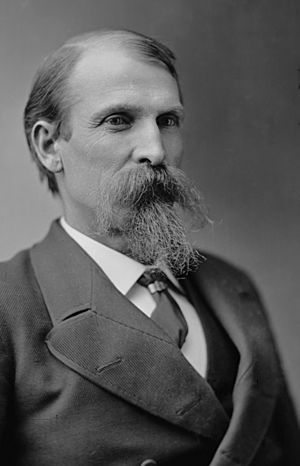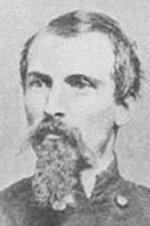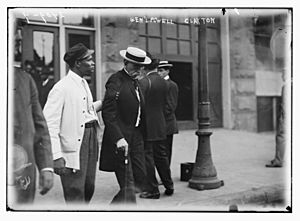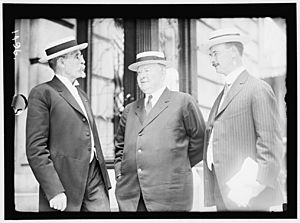Powell Clayton facts for kids
Quick facts for kids
Powell Clayton
|
|
|---|---|
 |
|
| 1st United States Ambassador to Mexico | |
| In office January 3, 1897 – May 26, 1905 |
|
| President | William McKinley Theodore Roosevelt |
| Preceded by | Position established |
| Succeeded by | Edwin Conger |
| United States Senator from Arkansas |
|
| In office March 4, 1871 – March 3, 1877 |
|
| Preceded by | Alexander McDonald |
| Succeeded by | Augustus Garland |
| 9th Governor of Arkansas | |
| In office July 2, 1868 – March 4, 1871 |
|
| Lieutenant | James M. Johnson |
| Preceded by | Isaac Murphy |
| Succeeded by | Ozra Hadley (acting) |
| Republican National Committeeman for Arkansas |
|
| In office 1877-1898 |
|
| U.S. Ambassador to Mexico | |
| In office 1897-1905 |
|
| President of the Eureka Springs Railroad | |
| In office 1883–1899 |
|
| Preceded by | Railroad established* |
| Personal details | |
| Born |
Powell Foulk Clayton
August 7, 1833 Bethel Township, Pennsylvania, U.S. |
| Died | August 25, 1914 (aged 81) Washington, D.C., U.S. |
| Resting place | Arlington National Cemetery 38°52′45.1″N 77°04′19.8″W / 38.879194°N 77.072167°W |
| Political party | Republican |
| Spouse |
Adaline McGraw
(m. 1865) |
| Relatives | John M. Clayton (brother) Thomas J. Clayton (brother) W. H. H. Clayton (twin) |
| Education |
|
| Signature | |
| Military service | |
| Allegiance | |
| Branch/service | United States Volunteers |
| Years of service | 1861–1865 |
| Rank | |
| Commands |
|
| Battles/wars | |
Powell Foulk Clayton (August 7, 1833 – August 25, 1914) was an important American leader. He was a soldier, a politician, and a diplomat. He served as the 9th governor of Arkansas from 1868 to 1871. Later, he became a U.S. Senator for Arkansas from 1871 to 1877. He also served as the U.S. Ambassador to Mexico from 1897 to 1905.
During the American Civil War, he was a high-ranking officer for the Union Army. He led cavalry troops in battles. After the war, he moved to Arkansas. He became governor when the state was rebuilding after the war. He faced many challenges, including violence from groups like the Ku Klux Klan. He worked to bring peace and improve the state.
After his time as governor, Clayton became a U.S. Senator. He was later appointed as an ambassador. He also helped build railroads and develop towns in Arkansas. He passed away in 1914 and was buried in Arlington National Cemetery.
Contents
Early Life and Beginnings
Powell Foulk Clayton was born in Bethel Township, Pennsylvania. His family had been in Pennsylvania for a long time. He went to school in Delaware and Pennsylvania. He studied how to build things as a civil engineer.
In 1855, he moved to Kansas. He worked as a surveyor, measuring land. He also bought and sold land. He got involved in local government. He became the city engineer in Leavenworth, Kansas.
Fighting in the Civil War
In May 1861, Clayton joined the U.S. Army as a captain. He fought mainly in Arkansas and Missouri. He showed great leadership in the Battle of Wilson's Creek in Missouri. He was promoted to lieutenant colonel in December 1861. By March 1862, he was a colonel.
At the Battle of Helena in Arkansas in 1863, Clayton led the cavalry. He was praised for his actions. His troops helped capture Little Rock later that year.
In October 1863, Clayton was in charge of federal troops in Pine Bluff, Arkansas. During the Battle of Pine Bluff, he successfully defended the town. His soldiers used cotton bales to build barricades. He also helped other Union forces during the Camden Expedition.
Clayton was highly respected by his soldiers and even by his enemies. One Confederate officer called him "clear-headed, quick to conceive, and bold and rapid to execute." Clayton became a brigadier general in August 1864. When the war ended in 1865, he was leading a cavalry division. While serving, he invested in cotton. This helped him buy a plantation in Arkansas after the war.
Becoming Governor of Arkansas
After the Civil War, Clayton helped start the Republican Party in Arkansas. He felt that people who supported the Union needed protection. This was because of conflicts with former Confederate soldiers.
In 1867, Congress passed new laws for states that had left the Union. These laws said states needed new constitutions. They also had to give civil rights to formerly enslaved people. Arkansas was under military rule. A new constitution was written.
Clayton was chosen to run for governor. He won the election. On July 2, 1868, he became the governor of Arkansas. The new state legislature agreed to the Fourteenth Amendment. This amendment gave equal rights to all citizens.
As governor, Clayton faced many challenges. Groups like the Ku Klux Klan caused violence against African Americans and Republicans. A Congressman was killed, and Clayton himself survived an attack. Clayton fought back by putting parts of the state under military control for four months. He used the state militia to stop the violence.
During his three years as governor, Clayton and the Republicans made many improvements. They issued bonds to build railroads across the state. They also started the first free public school system in Arkansas. The state also opened Arkansas Industrial University, the Arkansas School for the Deaf, and moved the Arkansas School for the Blind.
Political Challenges
During Clayton's time as governor, the Republican Party in Arkansas split. Clayton and his supporters were called "Minstrels." Another group, led by Joseph Brooks, was called "Brindletails." These groups had different ideas about how to rebuild Arkansas.
In 1869, some people accused Clayton of corruption. They said he misused his power. These political disagreements led to a difficult time known as the Brooks-Baxter War. Clayton was even accused of wrongdoing by the state legislature in 1871. However, the case against him was never fully heard.
Serving as a U.S. Senator
In January 1871, the Arkansas legislature elected Clayton to the United States Senate. At first, he didn't want to take the job. He didn't want his political rival, James M. Johnson, to become governor. So, Clayton arranged for Johnson to get a different job. Then, Ozra Hadley became the acting governor. In March 1871, Clayton was elected to the Senate again, and this time he accepted.
While in the Senate, he worked on committees. Some people tried to accuse him of wrongdoing from his time as governor. They claimed he had certified election results unfairly. Clayton explained that he had followed the state Supreme Court's ruling. He said he only certified votes from legal polling places.
The Senate investigated these claims. After looking at many witnesses and documents, a special committee found no evidence against Clayton. They said the accusations came from his political rivals. The Senate voted to accept these findings.
While in the Senate, Clayton helped bring law and order to a dangerous part of Arkansas. He asked for Judge Isaac Parker to be moved to Fort Smith, Arkansas. Judge Parker, known as the "Hanging Judge," worked with Clayton's brother, William H.H. Clayton, who was the U.S. Attorney. Together, they helped reduce crime in the area.
In 1877, Clayton lost his Senate seat. The Democrats gained control of the state legislature and elected one of their own. Clayton moved back to Arkansas. He continued to practice law and support business growth.
Later Life and Public Service
In 1882, Clayton built a home in Eureka Springs, Arkansas. This town was becoming a popular resort. He became president of the Eureka Springs Improvement Company. He helped build homes and businesses there. This company also helped build the Eureka Springs Railroad. This railroad made it easier for tourists to visit the town. The company also built the Crescent Hotel, a famous landmark.
Clayton stayed active in the Republican Party. He was a member of the Republican National Committee for many years. In 1896, he helped William McKinley get the Republican nomination for president. After McKinley won, he appointed Clayton as the first ambassador to Mexico. Clayton served in this role until 1905.
After leaving his ambassador role, he lived in Washington, D.C.. He still managed his businesses in Arkansas. He passed away in Washington, D.C., on August 25, 1914. He was buried at Arlington National Cemetery.
Personal Life
On December 14, 1865, Powell Clayton married Adaline McGraw. They had five children, but one son died young. Their son, Powell Clayton, Jr., became a major in the U.S. Cavalry. He is also buried at Arlington National Cemetery. Two of Clayton's daughters married diplomats from other countries.
In 1868, Clayton had an accident while hunting. He lost his left hand when his rifle went off.
Clayton had two twin brothers, W. H. H. Clayton and John M. Clayton. Both also had important careers in Arkansas. William became a U.S. Attorney. He worked with Judge Isaac Parker to bring justice to the region. John was a politician who served in the Arkansas legislature and was elected to Congress. Sadly, John was assassinated in 1889. Clayton's other brother, Thomas J. Clayton, became a well-known lawyer and judge in Pennsylvania.
See also
- Brooks–Baxter War
- Clayton family
- List of American Civil War generals (Union)
- List of governors of Arkansas




